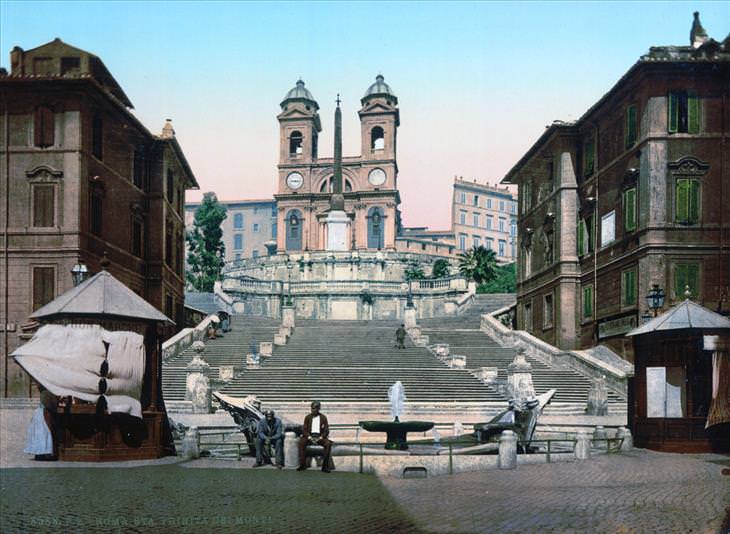The Acqua Felice Fountain
What makes these postcards so fascinating is that they were colored using an ingenious 'photochrom' process, a new invention of the time. Using photo negatives, the studio would create a mono-colored image of lithographic stone, and layer it with up to 15 different colored stone images to make a wonderfully lifelike multicolored postcard of Rome.
The Piazza Navona
Vesta's Temple
During the late nineteenth century, as in every previous age, Rome was the world's most famous city. Young noblemen would make Rome the high point of their ‘Grand Tour’, which aimed at immersing themselves in the classical culture that inspired their education. No doubt these Byronic young men had many female admirers back home to impress with these lush postcards.
The Temple of Castor & Pollux
The Temple of Bosco
Imagine the thrill one of those wide-eyed recipients of these stunning life-like postcards would feel when they received their mail from their friendly old postman! Unlike never before they would have pictured for themselves the great ‘Romantic’ city, where emperors and popes, poets and courtesans had lived so vivaciously for millennia. Almost every single postcard can tell a unique and terrific story from remote antiquity.
The Temple of Saturn &Triumphal Arch of Septimius Severus
St. Trinita Dei Monti
 Rome is full of famous structures that are pregnant with history. Take the following triumphal arch of Titus, below, which celebrates a great military victory. Emperor Domitian dedicated the arch to his predecessor brother, Titus, commemorating the infamous siege of Jerusalem of 70AD. Now the monument is a potent and tragic symbol of the terrible fate that has befallen the Jewish people throughout the ages.
Rome is full of famous structures that are pregnant with history. Take the following triumphal arch of Titus, below, which celebrates a great military victory. Emperor Domitian dedicated the arch to his predecessor brother, Titus, commemorating the infamous siege of Jerusalem of 70AD. Now the monument is a potent and tragic symbol of the terrible fate that has befallen the Jewish people throughout the ages.

Depicted in the arch are several spoils taken from the famously destroyed Temple of Jerusalem. These include the golden candelabrum of Menorah, which was originally painted yellow. This menorah from the arch served as the actual model for that depicted on the emblem of the state of Israel, founded in 1948. So, the arch actually helped return Israel to its stolen identity!
The Pyramid of Cestius
One of the best preserved ancient buildings in Rome is this magnificent Egyptian-style Pyramid of Cestius, built between 18 and 12 BC as a tomb for Gaius Cestius, a magistrate and powerful member of the Septemviri Epulonum, whose priestly duty was to arrange games, festivals, feasts, and banquets. As they say of Rome, it was all bread and circuses.
A view from the Palatine Hill
A view from the Palace of the Caesars
St. Peter's Palace
At St. Peter’s Square, the Basilica of which the apostle, Saint Peter, is said to be buried (and therefore many Popes too), there is a vast ancient obelisk, the only one in Rome to survive from antiquity. Originally erected in Heliopolis, Egypt, by an unknown Pharaoh, Augustus seized the obelisk before Caligula took it to Rome. It is a tremendous testament to Ancient Rome’s massive political power and their interest in other cultures and civilizations older than their own.
The Fountain of Trevi
The Trevi fountain is the great symbol of Rome’s baroque period, testimony to the city’s endurance as a cultural center. Yet this fountain also has ancient origins. Emperor Augustus was moved by an old legend that thirsty soldiers had been shown the spot by a young maiden, and he built there the Aqua Virgo (virgin water). This water served Rome for 400 years.
Inside St. Paul's
The Forum Romanum
The Roman Forum was the ancient hub of the bustling capital city of the Empire. Here triumphal processions were held, public speeches delivered, criminal trials were exercised and day-to-day business was done. It has often been referred to as the most celebrated meeting place in world history.
View from the Forum
The Forum Romanum
Trajan's Column
Trajan’s column is a remarkable structure that celebrates emperor Trajan’s victorious Dacian wars in an extraordinary spiral bas relief, which artistically depicts the key events of the wars.
The Bridge & Castle of St. Angelo
Outside the Colosseum
The postcard image people would most crave was an eyeful of the great Colosseum of Rome, known as the Flavian Amphitheatre. This greatest and largest of colosseums held an average of 60,000 enraptured spectators when it was completed back in 80 A.D. It was named after the Flavian dynasty of emperors who supported its construction and modification.
The Colosseum & Meta Sudans
Inside the Colosseum
During its heyday, the great Flavian amphitheater showcased terrific and shocking performances of mock sea-battles, acted dramas and musicals, bloody gladiatorial fights and bestial executions. Today some of this blood has been symbolically washed away by the site’s use during catholic celebrations, such as the Stations of the Cross, on special days like Good Friday.
The Fountain of the Naiads
On the Capitoline Hill
The Capitoline Hill is one of the seven great hills of Rome, this being this most important. Upon the ancient citadel of prehistoric and later Rome, the maiden Tarpeia reputedly let into Rome the Sabine enemies, for which treachery she was thrown off it to her death. It was henceforth known as Tarpeia’s rock.
The Piazza del Campidoglio
Garibaldi's Monument
Giuseppe Garibaldi, although born in the nineteenth century, is considered one of Italy’s founding fathers, because for many centuries Italy was not politically unified until his military success paved the way. Here he is celebrated as a patriotic hero, remembered for helping reunify his country and once again making Rome a great capital of a European power.

